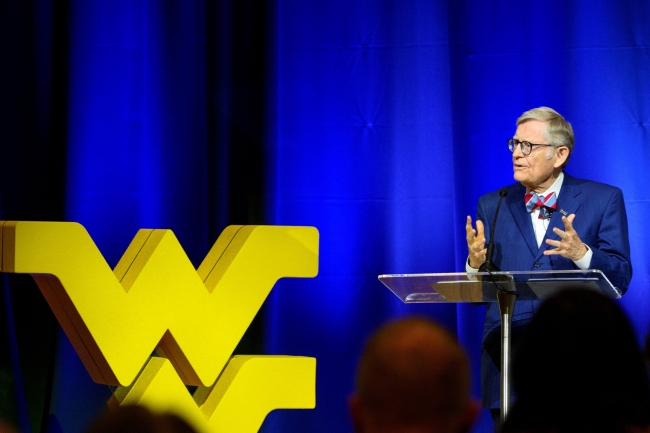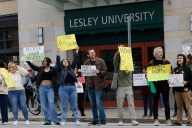You have /5 articles left.
Sign up for a free account or log in.

WVU president Gordon Gee delivering his State of the University address, where he announced plans to cut the university budget and adjust its strategic vision.
Matt Sunday/WVU Photo
At his semiannual State of the University address in March, West Virginia University president E. Gordon Gee gave a blunt assessment to a crowd of faculty, administrators, students and staff: WVU is too big—and its student body shrinking too fast—to operate sustainably.
With enrollment rates eroding and costs skyrocketing, the university had to shed weight, he said. Programs and positions that served the most students effectively would be prioritized; the rest were up in the air.
“When we put our students first, it brings everything into context,” Gee said in the address. “It crystallizes our priorities. And it shines a light on those things that may no longer be relevant.”
WVU leaders last month zeroed in on just how deep the cuts needed to be: $75 million would have to be trimmed from the budget to account for a projected 5,000 student enrollment decline over the next decade.
In an email to Inside Higher Ed, Gee said that while it is “too early to say” which programs or positions will be cut, “some things will need to change.”
“Moving forward, we are evaluating everything—from our operations to our academic programs to our services,” Gee wrote. “We are repositioning ourselves today so that we can be a responsive, relevant university system of the future.”
The cuts would make West Virginia’s flagship a smaller, leaner institution. Some observers say they could also make it more resilient and better prepared to compete in a changing higher ed landscape. Others worry that proactively implementing such large cuts amounted to a kind of surrender to lawmakers and austerity hawks who have long been starving the state’s public higher education institutions.
Tom Harnisch, vice president of government relations at the State Higher Education Executive Officers association (SHEEO), said he expects more flagships to follow in WVU’s footsteps. Already familiar with sharp, frequent cuts to higher ed funding, West Virginia is just the bleeding edge of a phenomenon that Harnisch said could affect even the most stable and renowned public institutions in the years ahead.
“Flagships are not immune to these challenges … Even the big institutions are going to have to get smaller,” he said. “It’s just a reflection of a new reality.”
A Canary in Coal Country
WVU isn’t the only flagship looking to shed weight and cut costs as federal pandemic aid runs out and a demographic cliff looms. Rutgers University in New Jersey faces a $125 million deficit, and its president has called for “multiyear solutions and structural reforms” while avoiding “draconian” measures. Penn State University has been roiled by reports of significant budget cuts and layoffs to make up for a nearly $150 million deficit.
Some public institutions have fought back against cuts tied to enrollment declines. Last week, the Connecticut State Colleges and Universities system launched a full offensive against lawmakers over what system president Terrence Cheng said would be “devastating” forced cuts if state funds don’t replace the federal relief money. Connecticut officials said the system had to put aside its “unrealistic” expansion goals and adopt a more sustainable strategic plan.
That’s precisely what WVU says it plans to do, though nobody involved is convinced it will be easy.
“Federal [COVID] aid really masked the financial impact of the demographic shift a bit, but it was just delaying the inevitable,” said Scott Wayne, a professor of mechanical and aerospace engineering at WVU and chair of the Faculty Senate. “It’s just going to be a challenging couple of years to adjust.”
Those growing pains could soon be shared by many public universities across the country, said Rick Staisloff, a former business officer at the College of Notre Dame whose consulting firm, rpk Group, advises colleges on budget efficiencies. He said institutions are facing a crossroads, and that most have taken one of three approaches: denying the necessity of serious cuts, attempting to put off the issue by temporarily filling budget holes left by dried-up federal aid or reworking their long-term plans and sloughing off nonessential expenditures.
“That last option, as of now, is unfortunately very rare,” he said. “But I think it’s long past overdue for institutions to take the more strategic view.”
Staisloff said flagships with big budget shortfalls like WVU and Penn State are “canaries in the coal mine,” warning other public institutions—even those on seemingly stable footing—to prepare for a future in which they may have to make difficult cuts.
“It wasn’t that long ago that people said, ‘Oh, the flagships have strong brand identity, good revenue, diversity, they’re outliers, they won’t really feel the effects.’ Well, here we are,” he said. “The good news is that when you enter periods of disruption, that presents enormous opportunity for positive change.”
Less Bloat, More Muscle?
Staisloff believes that making institutions leaner will also make them stronger going forward. Among other things, belt-tightening will help remedy the growing public cynicism around higher education’s value. The less bloated a university is, he said, the more it can invest in programs with a demonstrably positive impact on students’ employability and social mobility.
He’s helped a number of public institutions slim down. One of his clients, the University of Kansas—another flagship in a state with plummeting birth rates—provides an interesting case study for WVU.
When the COVID-19 pandemic hit in 2020, KU administrators—already worried that years of expansion had made operating costs unsustainable—quickly developed a cost-cutting plan to make up for a $75 million shortfall, Staisloff said. That plan resulted in the elimination of 42 low-enrollment academic programs last year, including Latin American studies and visual arts education.
“Rather than just struggle to hang on and hope that things get better, the [KU] leadership team says, ‘We’re going to move forward with a new model,’” Staisloff said. “They did the hard work in the midst of the pandemic to change themselves structurally … I believe that’s what good leadership looks like now.”
Kelly Allen, executive director of the nonprofit West Virginia Center on Budget and Policy, said that while she understands WVU’s difficult predicament, she fears its proactive, almost eager approach to efficiency measures will only embolden state officials to withhold funding in the future.
“There’s probably a sense among higher ed leadership that fighting for more funding is a worthless pursuit right now, but it really feels like letting lawmakers off the hook,” she said.
At the same time, she’s worried that shrinking the university will do more to hamper recruitment than improve it.
“Spending is already down so much from a decade ago, and that’s had really stark consequences for tuition, faculty pay, educational quality … It’s a vicious cycle,” she said. “It’s shortsighted to invest less in higher education at a time when the state workforce really needs more from its institutions.”
Even some faculty members—many of whom could lose their jobs or see their programs eliminated under WVU’s austerity plan—said they realized restructuring was a wise response to unfortunate but inescapable circumstances. Wayne said that while he was surprised by the size of Gee’s proposed $75 million adjustment, he understands the overall vision and believes the university’s early, transparent approach has made the prospect more manageable.
“We’re absolutely concerned about colleagues who may lose their positions, and we’re asking for transparency and input in this process. But the reality is, it’s going to be a relatively rapid transition,” he said. “I think in the end, the university will come out of this situation in a better position.”
Cutting Taxes—and University Budgets
In addition to federal COVID aid and high inflation, West Virginia’s oil, coal and natural gas severance taxes—state-imposed taxes on the extraction of nonrenewable natural resources to be used in other states—helped bring the state budget surplus to a record $1.3 billion this year.
The historic overflow led members of the state higher education commission to hope that, at the very least, they wouldn’t have to brace for another round of cuts. But their optimism was misplaced: Governor Jim Justice signed a budget this cycle that would return nearly two-thirds of the state’s surplus to taxpayers in the form of cuts and rebates. Meanwhile, overall funding for WVU fell, thanks to a new formula that rewards recruitment and retention—two areas that WVU, like many institutions, struggled with during the pandemic.
Allen said the drop in state support was “unfortunately not surprising.” Over the past decade, West Virginia has slashed $156 million of higher education funding—a nearly 25 percent drop in overall support, accounting for inflation—while tuition has risen almost 58 percent, according to a study conducted by Allen’s organization in October.
“We have this huge surplus, but we prioritized a massive tax cut instead of reinvesting in our public institutions to make up for years of cuts and attrition,” Allen said.
West Virginia’s tax cuts may be one of the country’s sharpest, but they are by no means unique: lawmakers across the country are taking advantage of historic budget surpluses to pass sweeping cuts.
Harnisch said he was concerned that these tax cuts will eat into future revenue and leave historically underfunded higher education systems vulnerable to even more extreme disinvestment in the future.
“These surpluses aren’t going to be around forever to provide a cushion,” he said. “In a few years the revenue will dry up, and then I’m worried higher ed will really be on the chopping block in a lot of these states.”









